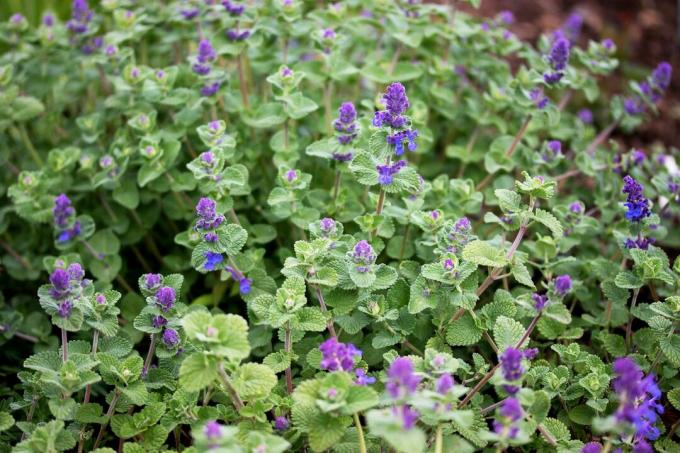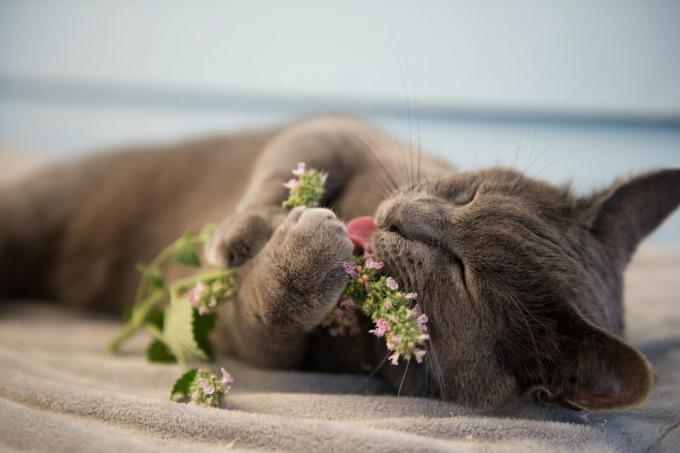If you want to do something good for your house cat, plant catnip. We show what you should know about buying, caring for and the effects of catnip.

Irresistible for cats, a feast for the eyes in the garden and also versatile in the kitchen: catnip (Nepeta). In addition, catnip is easy to care for and undemanding, making it a real jackpot for your garden, room or balcony. In this article we tell you everything you need to know about the origin, purchase, planting, care and use of catnip.
contents
- Catnip: origin and properties
- Catnip Types and Varieties
- Buy catnip
- plant catnip
-
care for catnip
- Pour catnip
- Cut catnip
- Fertilize catnip
- Effect of catnip on cats
Catnip can be used in a variety of ways: in perennial beds, they harmonize beautifully with roses; small species are often used for edging beds or for stabilization on slopes. It goes just as well in the scent bed as in the herb bed.
bees like to feast on the lush blooms, as do other beneficial pollinators. Cats love the smell of the herb, and the flowers and leaves can also be used as a medicinal and spice plant. So many good reasons to grow your own catnip. You don't necessarily need your own garden for this. Mint thrives just as well in pots on the patio or in balcony boxes. Catnip is even good as a houseplant. So it's high time to get yourself the miracle herb.Catnip: origin and properties
Originally, the special mint comes from different parts of the world: Europe, Africa and Asia. This also explains why there are over 250 different species of this genus worldwide. Catnip can now be found on almost every continent. Whether in hot and dry regions, in high mountains or steppe landscapes - members of the catnip species feel at home almost everywhere.
Most catnip species are perennial, but there are annual species as well. They are mostly herbaceous plants that form clumps. Depending on the species, the stems can be smooth or covered with small hairs. The leaves of catnip are arranged opposite each other on the stem. Depending on the species, they are more greenish or greyish and exude a pleasant minty and lemony scent. Depending on the variety, catnip bloom purple, white, blue or pink between April and July.
Catnip Types and Varieties
The variety of species and varieties of catnip is very large - so the choice is often not easy. We have put together the most popular types and some associated varieties for you below:
Nepeta x faassenii:
- ˈWalker's Lowˈ: This catnip variety impresses with its striking purple flowers and its long flowering period
- ˈSnowflakesˈ: This white flowering variety is ideal for perennial beds
- ˈglacier iceˈ: This variety is extremely robust and floriferous; it blooms white and blue
Nepeta racemosa:
- ˈOdeur Citronˈ: The French name already hints at the intense, lemony fragrance of this strain; cats tend to avoid her
- grog: This grey-leaved variety captivates with its subtle lemon scent and pink flowers
Nepeta grandiflora:
- ˈDawn to Duskˈ: This variety is characterized by its compact growth and pink to violet flowers
- ˈWild Catˈ: This variety is very vigorous and can also become quite large

Nepeta subsessilis:
- sweet Dreams: This catnip variety captivates with magnificent, light pink flowers with a lilac border
Buy catnip
Once you have decided to grow catnip, you can either sow it yourself or buy it as a plant. Sowing, however, involves more effort and takes longer; it is cheaper for that. If you decide to buy a plant that has already been grown early, you should know what to look out for when buying.
When buying catnip, the following points are crucial:
- type and variety
- health status
- Vigorous growth
- healthy roots
Make sure that the plant makes a vital and undamaged impression and is not affected by diseases. You can purchase catnip at garden centers, nurseries, or online.
We have summarized everything you need to know about buying catnip in this article.
plant catnip
Planting catnip correctly requires knowledge of the correct planting time as well as the location requirements of the plant. If you know about this and have instructions at hand, nothing can go wrong when planting your catnip. Catnip plants are best planted in the garden between late April and mid-May. If you prefer to sow your catnip yourself, the best time to do so is in spring, between mid-March and late April.
Even if the special mint is considered relatively undemanding, there are still some criteria to be considered when choosing a suitable location.
Location requirements of catnip at a glance:
- Sunny and bright
- Nutrient-rich, loose and well-drained soil
- pH around 6.5
- Not too wet

Once you have found the ideal location for your catnip, you can start planting. The best way to do this is as follows.
Planting catnip: instructions
- Loosen the soil at the planting site and remove weeds
- Enrich soil with compost or long-term fertilizer with organic long-term effect
- Dig a planting hole
- Planting distance: 30 cm
- Water well
A step-by-step guide and other important information about the Planting catnip you'll find here.
care for catnip
It is true that catnip is said to be very easy to care for and requires little attention - and that is the case. However, there are a few things you can do to make your catnip really happy.
Pour catnip
Catnip is found in almost every region of the world. It is therefore not surprising that the water requirements of the individual species are not always the same. A good rule of thumb is to look at the color of the leaves. Gray-leaved species are more resilient and can also cope well with prolonged drought. Green-leaved species, on the other hand, are more sensitive and need to be watered regularly to keep them from drying out. In general, you should be careful not to water too much, as waterlogging can be extremely damaging to the plants. It is better to water moderately and more often if necessary.
Summary of watering catnip:
- Grey-Leaved Species: Drought tolerant
- Green-Leaved Species: Water regularly
- Better to water too little than too much
- Avoid waterlogging
Cut catnip
The most common reasons for pruning catnip are to prolong the flowering season or to prevent the vigorous plant from spreading. If you want to enjoy the catnip flowering for as long as possible, we recommend cutting back the entire plant to just above the ground after the main flowering period in July. This allows catnip to bloom into autumn. To prevent the herb from spreading, cut the shrub back to just above the ground in spring.
A detailed guide to Cutting catnip you'll find here.

Fertilize catnip
Catnip is very frugal when it comes to fertilizer requirements. Fertilization is usually not necessary. Too many nutrients are more likely to damage the plant, which is why when fertilizing catnip, less is more. Have the soil with you before planting compost or a fertilizer with an organic long-term effect - like ours Plantura organic universal fertilizer with organic long-term effect - enriched, so there is no reason to fertilize again in the next two years. In the third year after planting, you can add your catnip again if necessary after pruning in July nettle manure or fertilize slow-release fertilizer. Again, the distinction between gray and green-leaved species applies here: The undemanding species with gray Leaves usually do not require any fertilizer at all, while species with green foliage require annual fertilization can.
Effect of catnip on cats
There is of course a reason why catnip bears this very name. Cats feel magically attracted to the herb. The plant makes some cats euphoric and upbeat, while others have a calming effect. Why is that? Researchers don't know for sure. What is clear, however, is that catnip contains a substance called nepetalactone. This is similar to a sex hormone in cats and therefore puts them in a state of intoxication. So if you want to make your cat happy, put a catnip in the garden or in the room. If you don't like cats, you might want to reconsider catnip.
A detailed description of effects of catnip and further information on what it can be used for, we have prepared for you in our special article.
